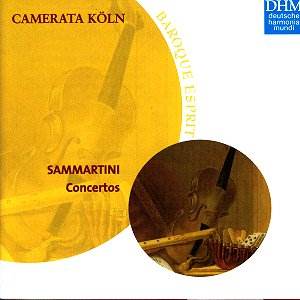I will get the gripes out of the way at the start.
The front cover of the CD bears the title Sammartini Concertos -
two words - each of which is misleading. The first word the - composer
- turns out to be two composers for there are works by Giuseppe and
Giovanni, the Sammartini brothers (although I have known musicians who
thought they were one composer known as G. Sammartini!). The second
word which describes the works is wrong (or half right if you like)
for there are three concertos on the disc, two trios and a sonata. What
could confuse the issue is that in the 18th century the word sonata
was sometimes used in its old fashioned sense of ensemble piece and
was therefore interchangeable with concerto. The notes in the
booklet say nothing of this and anyway, the Sonata in D for flute,
two violins and continuo by Giovanni is indeed just that and his
Trio in D a straight trio sonata. Another problem is that the
works of both brothers were sometimes published in different arrangements.
For example, some of Giuseppe’s chamber sonatas were re-arranged by
the Italian composer, Fernando Barsanti, into concertos. So, already
suspicious, I tried to cross reference the works with listings in the
Grove Dictionary of Music but was not able to do so with confidence
since there is little in the booklet notes to go on.
The notes, poorly translated from German, refer to
soprano and alto recorders which would confuse the British (a smallish
part of our international readership) who would know these as descant
and treble respectively. Also, readers might be led to believe that
the concerto for "violoncello piccolo, strings and b.c." has
a missing comma and is a piece for cello and piccolo (there’s a thought!)
rather than for a rare single instrument which is a species of small
cello. There is nothing about this instrument nor about what kind of
cello is used in the recording.
Having got that out of the way, we have an enjoyable
disc of a range of music from two talented and influential brothers
who inhabited a transitional period between baroque and early classical.
Their career paths were quite different, Giovanni being born and then
dying in Milan while Giuseppe eventually settled in bustling London
for the last twenty or so years of his life. Giuseppe’s more cosmopolitan
existence is reflected in his music on the disc which displays a pragmatic
ability to adjust his style. The violoncello piccolo concerto, for example,
is very italianate, clearly influenced by Vivaldi whereas his delightful
oboe concerto, excellently played by Hans-Peter Westermann,
is more Handelian in style. His recorder concerto is also very
tuneful and is a standard repertoire piece for skilled players. Michael
Schneider is a distinguished performer and I thought his playing one
of the best things about the disc which otherwise contains renderings
that are highly competent but not particularly special. He features
also in Giuseppe’s Trio in F major for 2 recorders which
for me was the most enjoyable work in spite of its three movements lasting
little more than five minutes. The slow movement with the recorders’
clashing semi-tones and tones is exquisitely intense.
Giovanni died a quarter of a century after his brother
and his two chamber works here (he does not get a concerto on this disc
of "concertos"!) were probably written after his brother’s
death and are understandably more classical in feel. Both involve transverse
flute and I liked the spirited playing in works that I found neatly
formed but relatively dull compared with brother Giuseppe’s contributions.
John Leeman

